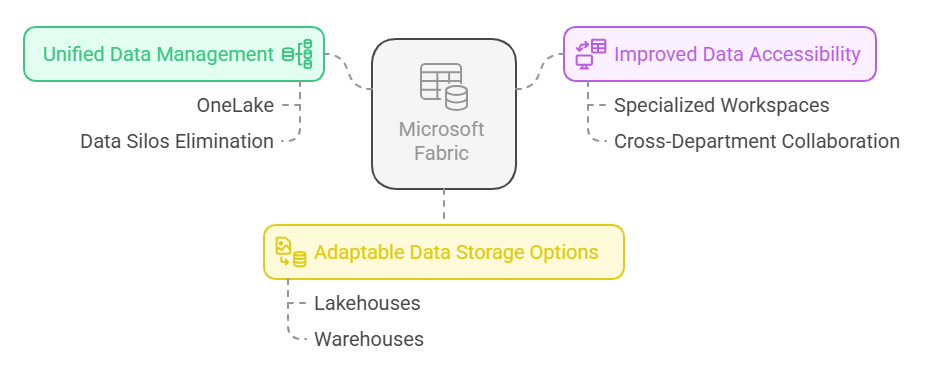Despite the availability of advanced technologies designed to streamline operations, many businesses still find it difficult to keep up with the competition. What’s standing in their way? Isolated data, disconnected systems, and a reactive approach to decision-making. These challenges create persistent barriers that hinder growth and agility. In the modern business world, data is one of the most powerful assets. Unlocking its potential through actionable insights is crucial. Imagine a unified, AI-driven platform that connects your entire data ecosystem, understands the context behind the numbers, and delivers insights faster than ever before. That’s exactly what Microsoft Fabric offers.
Microsoft Fabric is future of business intelligence because redefines what analytics platforms can do. It’s a smart, integrated solution that removes data silos, enhances efficiency, and brings intelligence to the forefront of business strategy. This article explores how Microsoft Fabric is transforming data management and helping organizations sharpen their competitive edge.
Why Microsoft Fabric is Essential for a Future-Ready Data Approach?
Microsoft Fabric is an advanced AI-powered analytics platform that combines the capabilities of Microsoft’s leading data tools, including Azure Data Factory, Azure Synapse Analytics, and Power BI. It delivers a unified experience that enables organizations to easily connect, transform, analyze, and visualize their data.
Modern data strategies focus on reusability, data mesh principles, and removing redundancies. Microsoft Fabric supports these goals by integrating data from various systems to ensure consistency, accuracy, and easy access.
With a strong and scalable architecture, Fabric upholds data quality across the organization, allowing businesses to expand while maintaining the reliability and value of their data.
Why Microsoft Fabric’s Integrated Platform Stands Out?
Unlike traditional platforms that operate in silos, Microsoft Fabric breaks barriers between departments, data, and decision-making. Here are the key reasons why it stands out as a game-changer in the modern data ecosystem:

Unified Data Storage with OneLake
OneLake is a central component of Microsoft Fabric’s integration capabilities. It is a managed Data-Lake-as-a-Service that serves as a unified storage solution for both internal and external data sources. With the help of “Shortcuts,” OneLake enables users to access and work with data without physically moving it, which simplifies data consolidation and reduces the workload associated with extract, transform, and load (ETL) processes.
Collaborative and Role-Based Workspaces
Workspaces in Microsoft Fabric provide shared environments where teams can collaborate on different data projects. Each workspace is designed to suit specific roles such as data engineering, data science, or data warehousing. These environments include the tools and resources relevant to each role, helping teams work more efficiently and ensuring all stakeholders can easily access and use the data.
Flexible Lakehouse and Warehouse Solutions
Microsoft Fabric offers Lakehouses and Warehouses as adaptable storage options that handle both structured and unstructured data. Lakehouses combine the scalability of data lakes with the high performance of data warehouses, enabling efficient storage, management, and analysis of data. Warehouses provide a familiar SQL-based database environment, enhanced with features like virtual warehouses and separate storage and compute layers. This architecture simplifies scaling and improves the management of complex data workloads.
Integrated Data Pipelines for Efficient Data Handling
Microsoft Fabric utilizes Azure Data Factory to offer a powerful data integration solution through its pipelines. These pipelines help collect data from diverse sources, automate various workflows, and ensure data quality through effective transformation processes. When integrated with other features of Microsoft Fabric, they enable organizations to build reliable and scalable systems that support real-time data processing and analytics.
Comprehensive Tools for Data Analysis
Microsoft Fabric brings together powerful data analysis tools like SQL analytics and Power BI, allowing users to extract meaningful insights from their data. SQL analytics provides access to data stored in Lakehouses, specifically for viewing or analyzing, without the ability to modify it. Power BI complements this by enabling users to create clear, interactive visuals such as charts and graphs, making complex data easier to interpret. Together, these tools simplify data analysis and reporting, helping teams across the organization make informed decisions.
Flexible Integration with External Tools
Microsoft Fabric is built to integrate smoothly with third-party tools and services, allowing organizations to continue using their existing technologies. For example, the SQL analytics endpoint can connect with tools like SQL Server Management Studio, giving users the ability to run queries and perform analysis through interfaces they are already comfortable with. This level of flexibility ensures Microsoft Fabric can align with various business needs and operational workflows.
How Microsoft Fabric Enhances Customer Data Assessment?
Microsoft Fabric empowers organizations to extract accurate, timely, and actionable insights from customer data. Below are key customer data enhancements it brings to the table.

Unified Data Management
A major obstacle in assessing customer data is dealing with fragmented data stored in separate systems, which can limit analysis and create disjointed insights. Microsoft Fabric tackles this challenge with OneLake, which consolidates data from multiple sources into a single platform. This eliminates data silos, streamlines reconciliation processes, and ensures that all teams access uniform, trustworthy information. Such centralized data management supports more accurate and comprehensive customer assessments, leading to improved decision-making and long-term strategy development.
Improved Data Accessibility
Assessing customer data effectively requires collaboration across departments such as sales, marketing, and customer support. Microsoft Fabric enables this through specialized workspaces designed for different roles, including Data Engineering, Data Science, and Data Warehousing. These workspaces act as shared environments where teams can easily access, collaborate on, and manage data-related tasks. With all tools available in a single platform, teams can work more efficiently, ensuring consistent insights and well-aligned strategies.
Adaptable Data Storage Options
Customer data appears in multiple formats, including structured transactional records, semi-structured inputs, and unstructured sources like social media posts and customer reviews. Microsoft Fabric provides storage flexibility through Lakehouses and Warehouses. Lakehouses combine the strengths of both data lakes and data warehouses, making it easier to handle a wide range of data types. They support high-performance delta tables for structured data and allow storage in common formats such as CSV, JSON, and PDF.
Is Microsoft Fabric the Right Fit for Your Organization?
If your organization is aiming to establish a modern data platform, Microsoft Fabric offers a powerful solution with a wide range of capabilities. Its ability to speed up the development of business logic, along with a constantly evolving set of features, makes it an attractive choice for many businesses. Still, it’s important to evaluate whether Fabric’s current features, especially its available connectors and deployment options, align with your specific needs.
To get the most out of Microsoft Fabric, it’s advisable to follow key best practices. These include organizing workspaces efficiently, managing capacity to control costs, and staying updated on the latest improvements. With the platform still growing, early adopters have a great opportunity to lead their industries by boosting innovation and streamlining data processes. Here are some top Microsoft Fabric case studies for reference.
Microsoft Fabric is steadily emerging as a major force in the data platform space. If you’re thinking about exploring its potential, now could be the ideal time to begin and secure a competitive advantage. Contact us to learn more about how Microsoft Fabric can transform your data strategy and unlock valuable insights tailored to your business needs.
FAQs
Yes, Power BI is natively integrated with Microsoft Fabric, allowing seamless access to data across the platform.
The primary purpose of Microsoft Fabric is to provide an all-in-one data platform that unifies data integration, engineering, analytics, and business intelligence. It enables organizations to manage and analyze data more efficiently using a single, integrated environment.
Microsoft Fabric is built for organizations aiming to leverage their data for strategic growth. It supports a wide range of users involved in the analytics lifecycle, including data engineers, analysts, and business decision-makers.
Connect with a Microsoft Fabric expert!









